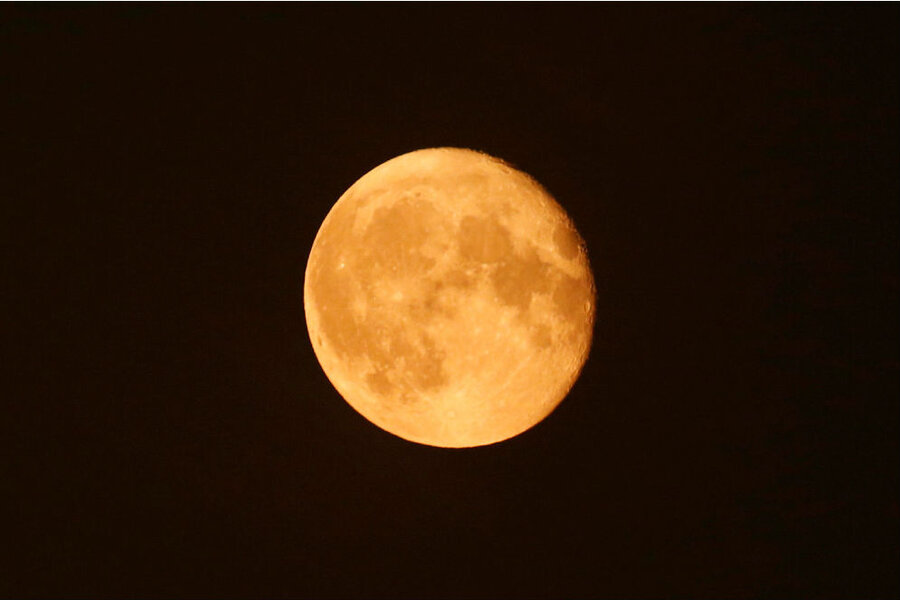Did the moon help to tip Earth right-side up?
Loading...
Despite centuries of study, scientists still have some fundamental questions about the origins of the moon.
Most agree with the theory that the moon was created in a massive collision about 4.5 billion years ago, when Earth was grazed by a Mars-sized object dubbed Theia, named after the Titan who gave birth to Selene, goddess of the moon. But this impact theory doesn't fully explain the differences between the Earth's and moon's orbital tilts and the identical isotopic makeup of some Earth and moon rocks.
A team of researchers has put forth another version of the collision hypothesis that may provide a number of solutions to these problems with the current model. In a new study published in the journal Nature, the team suggests that some of the holes in the collision theory could be explained within a framework of a more violent impact than the generally accepted model.
"Evidence suggests a giant impact blasted off a huge amount of material that formed the moon," Douglas Hamilton, professor of astronomy at the University of Maryland and a co-author of the study, said in a statement. "This material would have formed a ring of debris first, then the ring would have aggregated to form the moon. But this scenario does not quite work if the Earth’s spin axis was tilted at the 23.5 degree angle we see today."
Under the currently accepted model, the debris that formed the moon should have orbited in a ring along Earth's equatorial plane. Then, as it coalesced and moved away from the Earth due to tidal forces, it should have fallen in line with the ecliptic plane of the Earth's orbit around the sun. But the moon's orbit is actually 5 degrees off from the ecliptic.
"This large tilt is very unusual. Until now, there hasn’t been a good explanation," Dr. Hamilton said. "But we can understand it if the Earth had a more dramatic early history than we previously suspected."
The new theory supports the more recent hypothesis that the proto-Earth that Theia slammed into was spinning very quickly and with a much more extreme tilt, as a result of other early impacts.
According to the computer models used in the new study, the moon's current 5-degree orbital tilt may be explained the result if the initial orbital tilt of the moon relative to the ecliptic was actually much larger in the past. This new, more energetic model helps explain why the angle was initially so extreme.
They calculated that 4.5 billion years of gravitational arm-wrestling between the sun, Earth, and moon has pushed the moon out to its current distance and removed angular momentum from the system.
Those forces also shifted Earth's axis to a more upright position and slowed its rotation to the 24-hour period we know today. The moon, too, has had spin slowed as a result of this gradual change. It now rotates exactly once per revolution, which is why it always shows the same face to the Earth.
"As the moon moved outward, the Earth’s steep tilt made for a more chaotic transition as the sun became a bigger influence," lead author Matija Ćuk of the Search for Extraterrestrial Intelligence (SETI) Institute explained. "Subsequently, and over billions of years, the moon’s tilt slowly decayed down to the five degrees we see today. So today’s five degree tilt is a relic and a signature of a much steeper tilt in the past."
Their impact model also helps explain why Earth and the moon share nearly identical isotope ratios for many elements, which are quite different from those found in other parts of the solar system. They suggest a massive collision, violent enough that the disk of ejected material came from Earth's mantle, with little to no material from Theia. They first proposed that theory four years ago, but they couldn't fully explain how the Earth-moon-sun system could dissipate the leftover energy until now.
"What's beautiful about this work is that we can end up with the current state of the moon — its orbit, its chemistry — with just one step, without invoking any other event," Sarah Stewart, a planetary scientist at the University of California, Davis, and a senior author of the new study, told Space.com. "We don't invoke a sequence of events that needs to be just right to explain the moon's current state."
In addition to helping understand the history of our own planet, the team's new model could explain how to produce a habitable planet elsewhere in the universe. Scientists believe that an unusually large moon like our own may be instrumental in enabling processes that support life, such as creating tides and regulating the mild axial tilt that allows seasons to occur.
"Despite smart people working on this problem for fifty years, we’re still discovering surprisingly basic things about the earliest history of our world," said Dr. Ćuk, the lead author of the paper, in a SETI statement. "It’s quite humbling."








